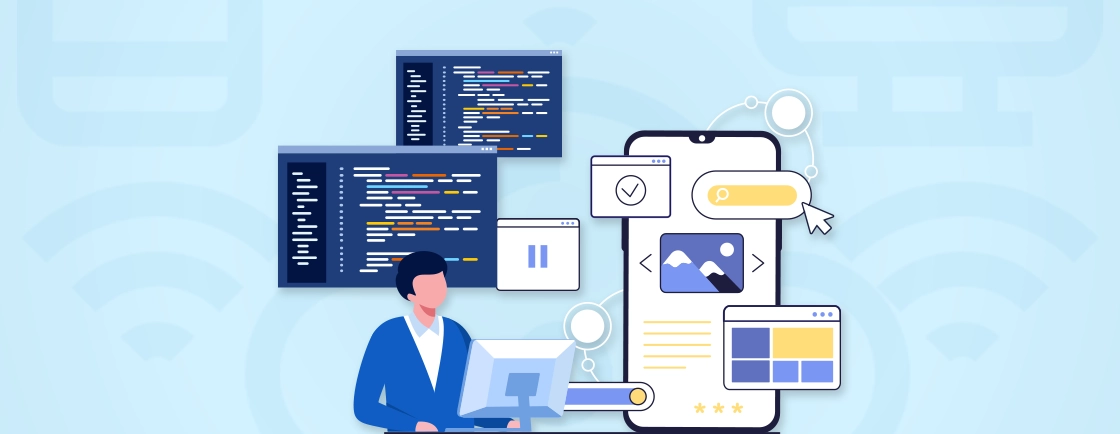Table of Contents
Imagine a sales guy closing a purchase in store through a tablet while roaming around the store with the customer. Or a warehouse manager tracking inventory in real time. Enterprise mobile apps make it all possible. These powerful tools offer agility, productivity, and a competitive edge.
But building a mobile app that truly meets enterprise needs—secure, scalable, and intuitive—isn’t simple. You need the right strategy, technology, and a user-centric design.
This blog will serve as a guide to enterprise mobile app development, from key trends to common pitfalls. By the end, you’ll be able to make informed decisions that drive real business results.
What is Enterprise Mobile App Development?
This approach focuses on creating secure, scalable, and high-performance apps that are business-focused rather than consumer-focused.
Unlike standard mobile apps, enterprise solutions are designed to streamline operations and enhance workforce productivity. And they integrate seamlessly with existing corporate systems like ERP, CRM, and cloud platforms.
These apps serve diverse functions like field service management, real-time analytics, and more. Enterprise mobile apps often handle sensitive data and must work across multiple devices. So security, compliance, and cross-platform functionality are critical.
So it’s important to hire dedicated mobile app developers. They drive efficiency, decision-making, and a competitive advantage for your project.
Types of Enterprise Mobile Apps
These apps are designed to solve particular business challenges, enhance productivity, and streamline operations. Here’s how we can broadly categorize them:
Marketing Automating
These apps help businesses automate repetitive marketing tasks. Like, social media posting, ad campaigns, and lead nurturing. They analyze customer behavior, segment audiences, and trigger personalized messages. It saves time while improving marketing ROI.
Email Marketing System
Mobile-friendly email marketing apps allow teams to create, send, and track email campaigns on the go. Features include drag-and-drop editors, A/B testing, and real-time analytics to optimize open rates and conversions.
Enterprise Resource Planning (ERP)
ERP apps integrate core business processes into a single system. Like, finance, inventory, supply chain, and manufacturing. Employees can access real-time data, approve workflows, and manage operations from anywhere. That means better efficiency.
Integrated Mobile Workforce
These apps support remote and field teams with tools for task management, GPS tracking, time logging, and communication. Industries like logistics, healthcare, and construction rely on them for seamless coordination.
Customer Relationship Management
Mobile CRM apps give sales and support teams instant access to customer data, interaction history, and deal pipelines. They help track leads, automate follow-ups, and improve customer service—all from a smartphone or tablet.
HR Management
HR apps help with everything from recruitment and onboarding to payroll and performance reviews. They simplify workforce management. Employees can request leave, check payslips, and complete training, while HR teams handle approvals and analytics on the go.
Automated Billing
These apps automate invoicing, payment processing, and expense tracking. They reduce manual errors, speed up transactions, and provide real-time financial insights. That is ideal for finance teams and service-based businesses.
Each of these apps plays a crucial role in modern business. They can help companies operate faster, smarter, and more efficiently.
How to Build an Enterprise Mobile App?
Enterprise mobile app development requires a structured approach. The aim is to ensure security, scalability, and seamless integration with business systems. Here’s a step-by-step process.
Determine the Business Goals & Requirements
Before coding begins, define the app’s purpose. It can be improving employee productivity, automating workflows, or enhancing customer engagement. Engage stakeholders to outline key features, user roles, and success metrics.
A clear roadmap prevents scope creep and ensures the app delivers real business value.
Choose the Right Development Approach
After defining the goals and requirements, you need to choose the best-possible development approach–native or cross-platform:
- Native Apps (iOS/Android): Best for performance and security but require separate development.
- Cross-platform Apps (Flutter, React Native): Faster development with a single codebase but may have limitations.
- Progressive Web Apps (PWAs): Web-based apps that work across devices but lack deep OS integration.
Select the approach based on budget, timeline, and app complexity.
Choose a Suitable Mobile Platform
If you opt for native apps, the next step is to select the best mobile app platform:
- iOS: Preferred for corporate environments with standardized devices (e.g., iPhones, iPads).
- Pros: Strong security, seamless updates, high-end user experience.
- Cons: Limited device flexibility, higher hardware costs.
- Android: Ideal for flexibility, customization, and cost-effective device options.
- Pros: Wider hardware options, customization, lower entry cost.
- Cons: Fragmentation (multiple OS versions), slower security updates.
- Hybrid/Cross-Platform: Useful if the app must run on multiple OSes with minimal differences.
- Pros: Cost-effective, quicker deployment, easier maintenance.
- Cons: Slight performance trade-offs, limited native features.
Before selecting the platform, you need to consider the security, user base, and app scalability.
Prioritize Security & Compliance
Enterprise apps handle sensitive data, so implement:
- End-to-end encryption: Secure data in transit (TLS/SSL) and at rest (AES-256).
- Secure Storage: Use platform-specific keychains (iOS) or Keystore (Android) for credentials.
- Multi-Factor Authentication (MFA): Require biometrics or OTPs for critical actions.
- Role-Based Permissions: Restrict features based on user roles (e.g., admin vs. employee).
- GDPR (EU), HIPAA (Healthcare), SOC 2 (Cloud): Ensure data handling meets legal/industry requirements.
- Regular Audits: Conduct penetration testing and vulnerability scans.
You need to adopt a “zero trust” approach—verify every request, even from internal users. Make sure to build protection into every layer.
Integrate with Enterprise Systems
Seamless integration with existing business software is critical for maximizing efficiency and data accuracy. Key integration points include:
- ERP/CRM Systems: Sync real-time data (orders, inventory, customer info) via APIs or middleware.
- Cloud Services: Connect to AWS/Azure for scalable storage and analytics.
- Legacy Systems: Use integration platforms (MuleSoft, Dell Boomi) for older on-premise tools.
Make sure of an API-first design, data sync logic, and effective error handling with this part of the procedure.
Optimize UX for Business Users
Enterprise apps must balance functionality with efficiency since users need to accomplish tasks quickly, often in high-pressure environments.
Let’s look at the key UX priorities:
- Role-based Interfaces: Custom dashboards for executives (analytics), field staff (quick data entry), and admins (configuration).
- Task-centric Design: Minimize clicks for frequent workflows (e.g., approval shortcuts, barcode scanning).
- Offline Resilience: Core functions (form submissions, document access) must work without connectivity.
After building the app, you need to shadow the users, i.e. the employees, to identify the pain points.
Conduct Quality Control Inspections
Rigorous testing ensures enterprise apps meet performance, security, and usability standards before launch. Let’s look at the critical testing phases.
- Functional Testing: Verify all features work as intended (e.g., form submissions, data sync).
- Performance Testing: Stress-test under heavy loads (1,000+ concurrent users) and slow networks.
- Security Testing: Penetration tests to uncover vulnerabilities like SQL injection or weak authentication.
- Compliance Audits: Validate adherence to GDPR/HIPAA if handling sensitive data.
- User Acceptance Testing (UAT): Real employees test in actual workflows to catch usability gaps.
Testing isn’t a phase—it’s a cycle. Continuous QA prevents costly downtime.
Building an enterprise app requires a strategic approach that balances business goals, robust security, and seamless user experience. To ensure success, it’s advisable to partner with expert mobile app development services providers that can deliver tailored solutions aligned with your enterprise needs..
Benefits of Enterprise Mobile App Development
As established at the start, enterprise apps drive efficiency, security, and competitive advantage by transforming business operations. Here’s how they add value:
Enhanced Productivity
Employees access critical tools (CRM, ERP) anytime, anywhere—reducing delays. Automation of repetitive tasks (approvals, data entry) speeds up workflows.
Real-time Decision Making
Live dashboards provide executives with instant KPIs for agile strategy adjustments. Field teams update job statuses on-site, improving operational visibility.
Strengthened Security
Centralized control over data access via encryption, MFA, and EMM solutions. Safer than paper-based processes or consumer-grade apps handling sensitive data.
Seamless System Integration
Connects with legacy software (SAP, Oracle) via APIs, eliminating data silos. Ensures consistency across departments (e.g., sales ↔ inventory updates).
Improved Customer & Employee Experience
Clients get faster service (e.g., support ticket tracking via mobile). Intuitive UX reduces training time and boosts workforce satisfaction.
Besides these benefits, enterprise apps reduce paperwork, manual errors, and reliance on desktop-bound processes. Furthermore, scalable cloud-based apps lower IT infrastructure costs.
Challenges With Enterprise Mobile App Development
While enterprise apps offer significant benefits, their development does come with some unique challenges.
Complex Integration Requirements
Legacy systems often lack modern APIs, requiring middleware or custom solutions. Ensuring seamless data flow between mobile apps and backend ERP/CRM platforms can be technically demanding.
Stringent Security & Compliance Demands
Enterprise apps must adhere to strict regulations (GDPR, HIPAA, SOC 2). Balancing usability with robust security (encryption, MFA, RBAC) adds complexity.
Cross-Platform & Device Fragmentation
Supporting multiple OS versions (Android fragmentation) and device types increases testing overhead. Ensuring consistent UX across smartphones, tablets, and rugged devices is challenging.
Scalability & Performance Issues
Apps must handle growing user bases without latency or downtime. Offline functionality needs careful synchronization logic to prevent data conflicts.
User Adoption & Change Management
Employees resist abandoning familiar tools, requiring training and intuitive UX design. Poorly optimized workflows lead to low engagement and wasted investment.
High Development & Maintenance Costs
Enterprise-grade features (security, integration, scalability) demand larger budgets. Ongoing updates, compliance checks, and support add long-term expenses.
But don’t worry about these challenges; our experts can take care of these hurdles to build the perfect enterprise apps for your business.
Let’s Summarize
Enterprise mobile apps aren’t just about technology. They transform how businesses operate, collaborate, and compete. It involves everything from streamlining operations with real-time data to empowering remote teams with secure tools.
However, success hinges on strategic planning. You need to align the app with business goals, prioritize security and usability, and ensure seamless integration with existing systems. Leveraging the mobility of these apps will help you gain agility, efficiency, and a decisive edge.
FAQs on Enterprise Mobile App Development
How long does enterprise app development typically take?
Timelines vary (3–12+ months), depending on complexity, integrations, and compliance needs. A minimum viable product (MVP) can launch in 3–6 months.
How do we ensure data security with enterprise apps?
Implement end-to-end encryption, MFA, role-based access, and regular penetration testing. Especially for regulated industries (healthcare, finance).
Can legacy systems integrate with mobile apps?
Yes, via APIs, middleware (MuleSoft), or custom connectors, though older systems may require additional development effort.
What about IoT integration in enterprise apps?
Many industries (manufacturing, healthcare) benefit from IoT-connected apps for real-time equipment monitoring or asset tracking.
Can we repurpose existing web apps for mobile?
Yes, through responsive design or PWAs, but native/hybrid apps often deliver better performance, offline access, and device-specific features.
Elevate Your App Development Journey
Explore comprehensive guides, industry trends, and expert advice to build innovative mobile applications.





